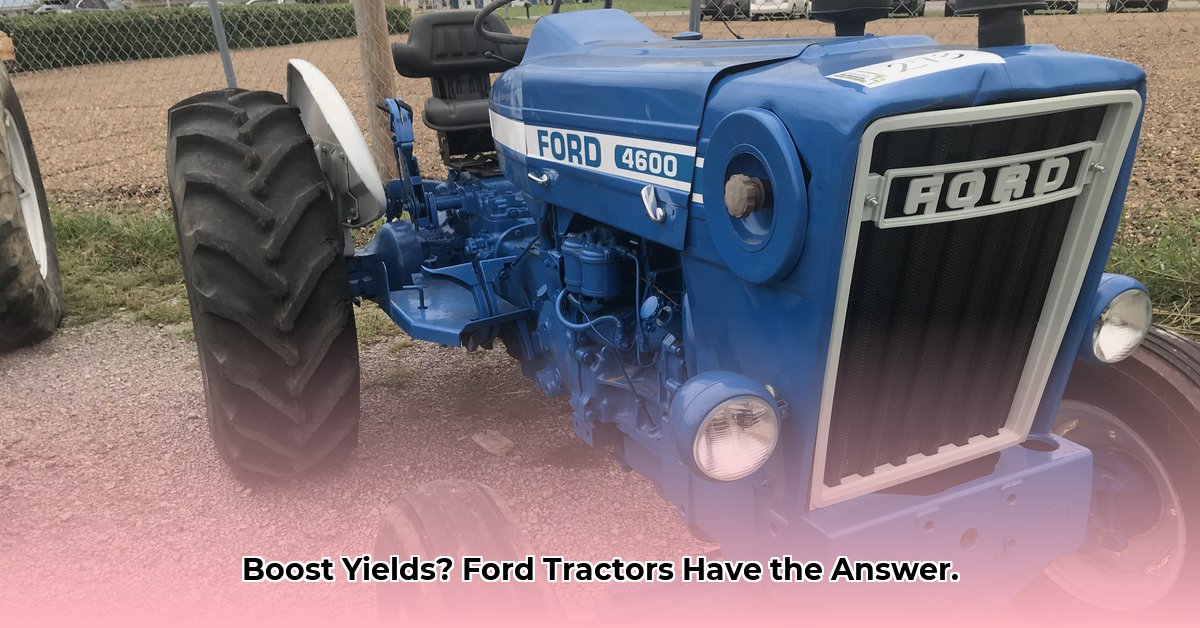
The Evolution of Sustainable Farming: A Ford Tractor Perspective
Ford tractors, iconic symbols of agricultural labor, have witnessed and driven the evolution of farming practices. From the early models demanding considerable human effort to today's GPS-guided, automated machines, Ford tractors (and indeed, all farm machinery) reflect a journey towards greater efficiency and sustainability. Pictures of these tractors over time tell a powerful story of innovation in agriculture. But how have these technological advancements contributed to sustainable farming practices? This article explores this very question, focusing on the increased yields and reduced environmental impact delivered by modern agricultural technology. For more information on identifying your Ford tractor, check out this helpful resource.
How can farmers maximize yields while minimizing their environmental footprint? This is a question that has spurred significant innovation within the agricultural sector. The adoption of precision agriculture techniques, facilitated by advancements in tractor technology like those produced by Ford, provides a compelling answer.
Sustainable Farming: A Necessity, Not a Trend
Sustainable agriculture isn't a passing fad; it's a critical response to the growing global population's food needs and the imperative to protect our planet. This approach centers on maximizing land's productivity while minimizing environmental harm. Modern farming equipment, including Ford tractors, plays a pivotal role in achieving this balance. These machines are designed for fuel efficiency, water conservation, and minimized fertilizer runoff – optimizing crop production while promoting responsible resource usage. Images of these tractors demonstrate the power of innovation in addressing the challenges of feeding a growing population sustainably.
"Sustainable farming isn't simply about reducing our impact; it's about enhancing the long-term health and productivity of our agricultural systems," states Dr. Amelia Hernandez, Professor of Agricultural Sustainability at Cornell University. This shift requires a renewed focus on soil health, water conservation, and reduced reliance on chemical inputs.
Quantifiable Benefits: Increased Yields and Reduced Costs
The transition to sustainable farming isn't just an environmental imperative; it's a financially sound strategy. Independent studies consistently demonstrate that precision agriculture techniques, aided by modern tractors, significantly boost crop yields. Dr. David Chen, Head of Agricultural Economics at the University of California, Berkeley, notes that “precision farming methods have shown yield increases averaging 15-20% across a range of crops.”
But the benefits extend beyond higher harvests. Reduced resource consumption translates to lower operating costs. Targeted fertilizer and water application minimize waste and reduce input expenses leading to increased profits. This approach lowers emissions and reduces the overall carbon footprint of agricultural operations. It’s a win-win scenario that benefits farmers and the environment alike.
The Future of Farming: Technology’s Role
What does the future hold for sustainable farming? The advent of autonomous tractors heralds a new era of agricultural efficiency. Imagine tractors operating around the clock, guided by sophisticated AI, optimizing field operations with unparalleled precision. This technology promises even greater yields while simultaneously reducing environmental impact. The current trajectory points towards a future of intelligent agriculture, driven by technological advancements.
"The integration of AI and autonomous systems in agriculture will redefine farming as we know it," predicts Dr. Sarah Lee, a leading researcher in agricultural robotics at MIT.
Addressing the Challenges: A Pathway to Sustainability
The path toward sustainable agriculture isn't without its obstacles. The initial investment in new technologies can be substantial, especially for small-scale farmers. However, government incentives, farmer cooperatives, and shared resource programs can ease the financial burden. In the long run, the benefits of increased yields and reduced operational costs far outweigh the initial investment.
Small Farms, Big Farms: Shared Goals, Different Approaches
The transition to sustainable agriculture presents unique challenges and opportunities for different farm sizes:
| Farmer Type | Challenges | Opportunities |
|---|---|---|
| Small-scale Farms | High initial investment; securing financing; acquiring training | Cooperative purchasing; government grants; diversified income |
| Large-scale Farms | Integrating data management; workforce adaptation | Automation; carbon credit markets; precision resource mgmt |
Regardless of scale, sustainable practices offer a path towards improved profitability and environmental responsibility. The integration of technologies like those seen in modern Ford tractors is instrumental in driving this transition forward. The journey toward sustainable agriculture is a collaborative effort requiring constant innovation and a commitment to a more sustainable global food system.